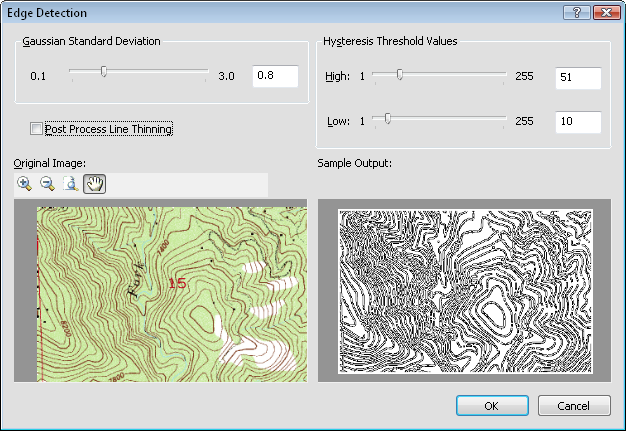
Click the Image | Processing Filters | Edge Detection command to accurately identify the edges of solid objects. Edges characterize boundaries and are therefore of fundamental importance in image processing. Edges in images are areas with strong intensity contrasts from one pixel to the next. Detecting an images edge significantly reduces the amount of data and filters out useless information, while preserving the important structural properties in an image.

Edge Detection simplifies the image to a series of lines that outline the edges of the original objects.
The Edge Detection dialog includes two key functions (Gaussian Standard Deviation and Hysteresis) to successfully identify the outline of an image object.
The Gaussian Standard Deviation option is used to smooth the image to look for horizontal, vertical, and diagonal edges through an image. Based upon the supplied value in the Gaussian Standard Deviation, Didger creates a convolution mask size. The Gaussian Standard Deviation is a value between the 0.1 and 3.0. When set to 0.1, shorter and more fragmented lines are created across the image. When set to 3.0, longer, more continuous lines are created across the image. To change the value, highlight the existing value and type a new value. Alternatively, click and drag the  to the desired value.
to the desired value.
Hysteresis helps to connect lines based on angles and pixel value connectivity. To achieve this, hysteresis uses two different threshold values: High and Low. To change the value, highlight the existing value and type a new value. Alternatively, click and drag the  to the right or left. The values range between 0 and 255. The High value marks out the strongest edges of an image. Hysteresis traces these high value edges through the image. The Low value traces faint sections of lines and avoids the few noisy pixels that do not constitute a line. Together these high and low values are able to identify edges and continuity in an image. Typically, the higher threshold can be set to approximately three times the lower threshold.
to the right or left. The values range between 0 and 255. The High value marks out the strongest edges of an image. Hysteresis traces these high value edges through the image. The Low value traces faint sections of lines and avoids the few noisy pixels that do not constitute a line. Together these high and low values are able to identify edges and continuity in an image. Typically, the higher threshold can be set to approximately three times the lower threshold.
Check the box next to the Post Process Line Thinning option to force a line thinning routine. This ensures all lines are one pixel wide. When unchecked, the line width can vary.
The immediate effects of the edge detection changes are displayed in the dialog. The image on the left side is the Original Image, as it appears in the project. The image on the right is the Sample Output, which displays the changes as the Gaussian Standard Deviation and Hysteresis Threshold Values are changed in the dialog.
Above the image are several buttons for zooming in or out on the image. Click the  button to enter zoom in mode. The cursor changes to
button to enter zoom in mode. The cursor changes to  to indicate zoom in mode. Click on the image to zoom in at the desired location. Click the
to indicate zoom in mode. Click on the image to zoom in at the desired location. Click the  button to the left of the image to enter zoom out mode. The cursor changes to
button to the left of the image to enter zoom out mode. The cursor changes to  to indicate zoom out mode. Click on the image to zoom out at the desired location.
to indicate zoom out mode. Click on the image to zoom out at the desired location.
Click the  button to zoom out to the entire extents of the image. The full image is displayed.
button to zoom out to the entire extents of the image. The full image is displayed.
Click the  button to enter pan mode. Click and hold the mouse button down. The cursor changes to
button to enter pan mode. Click and hold the mouse button down. The cursor changes to  to indicate pan mode. Drag the mouse around to move the image. Alternatively, click and hold the mouse wheel down to pan around the image.
to indicate pan mode. Drag the mouse around to move the image. Alternatively, click and hold the mouse wheel down to pan around the image.
As the zoom changes in the Original Image view, the same zoom appears in the Sample Output view. This way you can compare the same extents with the applied settings in both views.
Click OK to apply the edge detection to the image. Click Cancel to close the dialog without applying the edge detection to the image.
Grayscale images tend to show the most dramatic difference when changing the Hysteresis Threshold Values and Gaussian Standard Deviation values. If an image is not responding well to the edge detection, try converting the image to a grayscale image with the Image | Processing Filters | Convert to Grayscale command before applying the edge detection.
See Also